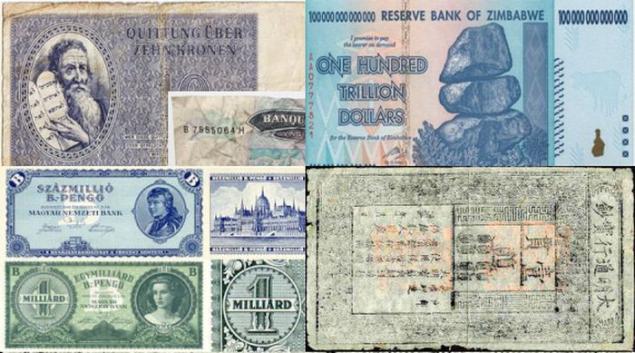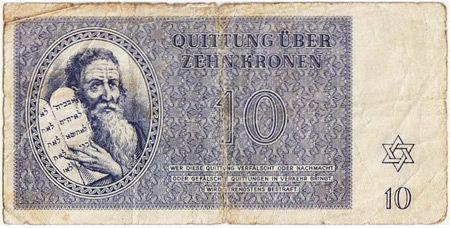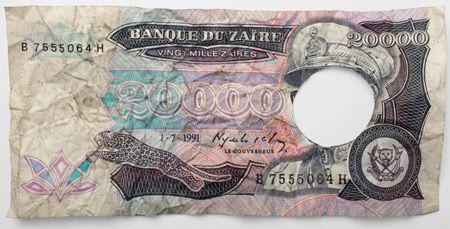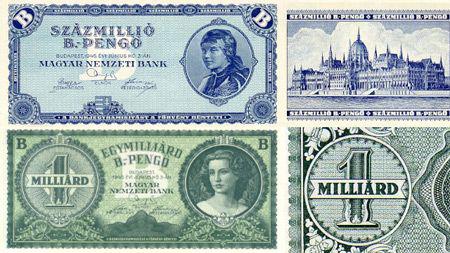The most unusual in the history of the banknote
 Bashny.Net
Bashny.Net
Little information about the number of banknotes from all over the world, which are considered the most unusual in the history.

The oldest banknote - 1380 (China)

The earliest known use of paper money belongs to China 800s AD. Banknote you see above - the oldest surviving. It was released around 1380.
Banknotes concentration camp (Czech Republic)

These notes Nazis created for walking in the Theresienstadt concentration camp, which was located in the former garrison town of Terezin in the Czech Republic, on the banks of the river Ohře. This camp is considered the Nazis "exemplary illustrative" - it showed the Red Cross and other international organizations as an example of good treatment of the Jews. There operated a synagogue, lecture halls, publishes magazines, performances and exhibitions were held. These notes 10 and 20 crowns, printed on plain paper, have become part of the Red Cross arranged for showing off, had no real value and have never been used.
Banknotes with a cut face of the dictator (Zaire)

In 1997, the African nation of Zaire (now the Democratic Republic of Congo) overthrew the totalitarian regime of Joseph Mobutu. When the new government was faced with a shortage of cash, they decided to temporarily use the old notes in the 20000 Zaire, cut out of them the image of the dictator.
One hundred trillion dollars (Zimbabwe)

In January 2009, the Reserve Bank of Zimbabwe began issuing banknotes in 100 trillion dollars local. At this point, the rate of inflation in Zimbabwe was the highest in the world. The bill, which you see above could be exchanged for $ 300. In July 2008, inflation reached mind-boggling figures of 231 million percent. Loaf of bread cost 300 billion Zimbabwean dollars.
100 million billion Pengo (Hungary)

Before World War II Hungarian Pengo experienced the highest inflation ever recorded. In 1946, in Hungary there were 100 million banknotes billion Pengo. If the figures, it will look like this: 100 000 000 000 000 000 000 Pengo. Prices doubled approximately every 15 hours, so in July 1946 the Hungarian Government abolished Pengo, replacing it with the forint, which remains the official currency of Hungary today. Banknotes, which you see above were actually printed, but never in circulation and were not.

The oldest banknote - 1380 (China)

The earliest known use of paper money belongs to China 800s AD. Banknote you see above - the oldest surviving. It was released around 1380.
Banknotes concentration camp (Czech Republic)

These notes Nazis created for walking in the Theresienstadt concentration camp, which was located in the former garrison town of Terezin in the Czech Republic, on the banks of the river Ohře. This camp is considered the Nazis "exemplary illustrative" - it showed the Red Cross and other international organizations as an example of good treatment of the Jews. There operated a synagogue, lecture halls, publishes magazines, performances and exhibitions were held. These notes 10 and 20 crowns, printed on plain paper, have become part of the Red Cross arranged for showing off, had no real value and have never been used.
Banknotes with a cut face of the dictator (Zaire)

In 1997, the African nation of Zaire (now the Democratic Republic of Congo) overthrew the totalitarian regime of Joseph Mobutu. When the new government was faced with a shortage of cash, they decided to temporarily use the old notes in the 20000 Zaire, cut out of them the image of the dictator.
One hundred trillion dollars (Zimbabwe)

In January 2009, the Reserve Bank of Zimbabwe began issuing banknotes in 100 trillion dollars local. At this point, the rate of inflation in Zimbabwe was the highest in the world. The bill, which you see above could be exchanged for $ 300. In July 2008, inflation reached mind-boggling figures of 231 million percent. Loaf of bread cost 300 billion Zimbabwean dollars.
100 million billion Pengo (Hungary)

Before World War II Hungarian Pengo experienced the highest inflation ever recorded. In 1946, in Hungary there were 100 million banknotes billion Pengo. If the figures, it will look like this: 100 000 000 000 000 000 000 Pengo. Prices doubled approximately every 15 hours, so in July 1946 the Hungarian Government abolished Pengo, replacing it with the forint, which remains the official currency of Hungary today. Banknotes, which you see above were actually printed, but never in circulation and were not.
Tags
See also
3 the most unusual circus world
The most unusual alternative currency
The most unusual places on the planet
The most unusual mobile phones in the world
Photo galleries of the most unusual shoes
The most ridiculous taxes in the history of mankind
5 most unusual vehicles MAZ
Art-bench: most unusual urban furniture
10 of the most famous in the history of betting

















